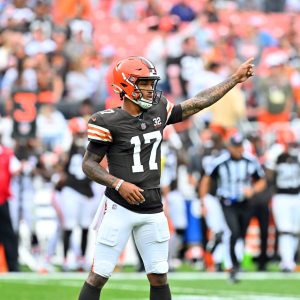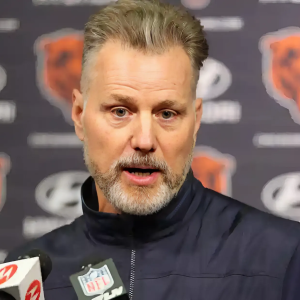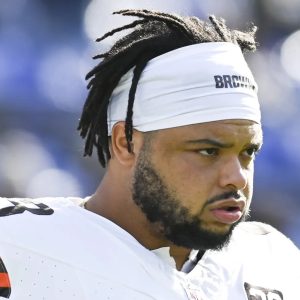
RENTON, Wash. — The Seattle Seahawks are creating their defensive identity and building the chemistry required to properly execute what has been described as a versatile and complex new scheme under head coach Mike Macdonald.
The Seahawks have held 10 training camp practices that have been open to the media, and here’s what we’ve learned so far about Macdonald’s new defense:
Rush by committee
Macdonald has shown signs of being willing to move his pass rushers around to try and confuse the offense. Seattle’s pass-rush packages traditionally featured a pair of outside linebacker types in the 265-pound range (think Frank Clark and Cliff Avril), a 300-plus pound interior rusher (think Jarran Reed) and a slimmer interior pass-rush specialist (think Michael Bennett or Quinton Jefferson). Macdonald follows those same patterns, to an extent, but he’s also willing to flip-flop and have those big guys on the outside and move his edge rushers in the middle. And because they can run games and stunts from these fronts, the offense has to be ready for anything; a defensive tackle aligning across a right tackle doesn’t mean he’ll be rushing against that player when the ball is snapped.
As was the case in Baltimore, Macdonald will blitz anyone. The Ravens in 2023 had one of the league’s lowest blitz rates but they led the NFL with 60 sacks largely because it was difficult for the offense to keep track of who was coming at the quarterback. Dropping defensive linemen into coverage was a point of contention in Seattle when Ken Norton Jr. was the coordinator, and his successor Clint Hurtt vowed to do less of that. But most play-callers in today’s game will have that in their toolkit because it’s part of having a multiple, tough-to-decipher scheme. Ravens All-Pro safety Kyle Hamilton had three sacks in Week 3 against the Colts and on two of those plays, both defensive tackles dropped into coverage; on the third sack, the two edge rushers dropped. I expect more of the same in Seattle.
Macdonald’s multiplicity allows him to throw anything at the offense, and it’s even trickier to decipher when the coach toys with the fronts.
How Mike Macdonald has NFL offenses guessing and defenses following his lead
Corners will rotate
Pete Carroll and his defensive coordinators preferred keeping cornerbacks on one side of the field, but Macdonald has a different philosophy. After playing solely on the right side his first two seasons, Riq Woolen will play left and right in Macdonald’s scheme. Devon Witherspoon will play nickel, left cornerback and right cornerback after only playing slot and left corner as a rookie. Tre Brown is often on the field when Witherspoon plays inside, and he’ll have the flexibility to play left and right.
“I feel like it makes it better just because you get to go against the best receiver,” Woolen said. “Whenever you get to go against the best receiver, they play on the right and on the left side. So I feel like that can be a great help to this team and that could be a great thing for me, just because I’m a competitor, and it shows that my teammates can trust in me to do the right thing.”

Riq Woolen says he welcomes playing both sides of the field in the Seahawks’ new defense. (Stephen Brashear / Associated Press)
Once the season begins, we’ll see whether Macdonald has his cornerbacks travel with the opponent’s top pass catcher. It’s harder to do that when the corners are glued to one side of the field but that won’t be an issue in Macdonald’s scheme. Witherspoon and Woolen like the idea of being moved around.
“Whenever you’re a great player like I am, you’ve got to do certain things, and that’s one of the things I want to do,” Woolen said. “I want to play both sides. I want to travel. I want to do stuff like that. I don’t think it’s hard at all. I’m an athlete. I trust myself and I’m confident in what I do.”
Riq Woolen, Geno Smith lead standouts through one week of Seahawks training camp
QBs will be tested
Throws outside numbers are generally tougher for quarterbacks to make, so sometimes you’ll see defenses function in a way that forces the passer to prove themselves in that facet. It’s early, but Macdonald seems to be trending toward having that sort of defense. It’s been interesting to see in training camp because Geno Smith is accurate at all three levels of the field, so he has no issue throwing out routes, deep comebacks, slot fades, back-shoulders and go balls to guys like DK Metcalf, Tyler Lockett and Jaxon Smith-Njigba. Smith can get in trouble sometimes — like when safety Julian Love robbed an out route on Day 2 of camp — but for the most part, Seattle’s starting quarterback is good at the throws the defense dares him to make, which is why there’s been such a good back and forth between the starting units when Smith is healthy.
The structure of Macdonald’s defense is also interesting in that regard because of the quarterbacks on the schedule. Early in the year, they’ll play Miami’s Tua Tagovailoa and Detroit’s Jared Goff, two quarterbacks who do damage over the middle of the field. San Francisco’s Brock Purdy and Los Angeles’ Matthew Stafford have torched the Seahawks over the middle in recent years. If Macdonald can close the middle off, he’ll theoretically create a schematic advantage the Seahawks haven’t had since the first half of the 2017 season.
Three things will be critical: stopping the run, cornerbacks winning their matchups on the outside and linebackers being able to cover. The latter was just as essential to those Legion of Boom-era defenses as anything the secondary did. Bobby Wagner and K.J. Wright were great underneath defenders at their peaks, and they complemented Kam Chancellor’s skills in the intermediate part of the field. If Tyrel Dodson and Jerome Baker, who’s currently out with a hamstring injury, can replicate some of what the linebackers of the past were able to do, then quarterbacks could have a hard time finding easy completions against Macdonald’s defense.
Disguise, disguise, disguise
The Seahawks played a simple scheme in the early days of the Carroll era then gradually attempted to be more diverse as their coordinators took head coach jobs around the league and their talent was no longer superior. Macdonald is basically the final form of that defensive evolution in that he may play similar single-high looks but his method of getting to those coverages will be different with more pre- and post-snap movement.
Everyone will move around in this defense but the players to watch will be the safeties. Rayshawn Jenkins’ post-snap movement and Love’s flexibility to play free safety, strong safety or nickel in three-safety looks with K’Von Wallace on the field can be the key to unlocking everything Macdonald wants to do on the back end. The experienced quarterbacks on the schedule like Josh Allen, Aaron Rodgers and Kirk Cousins will be able to sniff out some of these disguises, especially late in the season when there’s more tape to study, but the slightest hesitation can be the difference between winning and losing in a late-game situation. For Macdonald’s defense, the idea seems to be that the more offense is required to think and communicate, the tougher it’ll be to function.
How Julian Love exemplifies the Seahawks’ plan under Mike Macdonald
“With coach Macdonald’s system, I think the best way to describe it, we played them last year against Baltimore (and) it was the hardest defense we played against,” tight end Noah Fant said. “He does a great job of disguising, bringing pressure — all those things that we saw already in Baltimore. He’s a great coach for the defense and has been constantly on them.”
(Top photo: Stephen Brashear / Associated Press)




